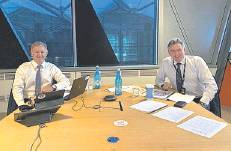NAB spruiks digital IDs to counter crims
James Frost
NAB chief executive Ross McEwan says individual digital IDs – a potential lightning rod for civil liberties advocates – could help the bank resolve concerns about its money-laundering program sooner than its current timeline of at least another year.
Mr McEwan said individual digital IDs could help to reduce the heavy burden on financial service companies covered by the Australian Transaction Reports and Analysis Centre (AUSTRAC), the increasingly assertive anti-money-laundering and counterterrorism-financing regulator.
The bank boss, speaking at a House Economics Committee hearing yesterday, said AUSTRAC’s assessment made earlier this week that the sector was at the highest risk of being exploited by criminals was well understood, and NAB was doing everything it could to close the gaps.
‘‘We have to know every customer, every product and every transaction in every jurisdiction,’’ Mr McEwan said.
‘‘I wasn’t at all surprised to learn banks are high risk, we are the conduit through which money flows and people are trying us on all the time,’’ Mr McEwan said.
NAB is in the midst of a multi-year process of improving its anti-money-laundering and counter-terrorism-financing (AML-CTF) detection and reporting systems under the watchful eye of AUSTRAC, which moved the engagement to the enforcement phase in June.
‘‘We have a remediation program that we’ve been working through with AUSTRAC over the last three years, and on that program we have at least another year to make sure we are fully compliant,’’ Mr McEwan said.
The bank would respond to the most recent series of requests from the financial intelligence regulator in about six to eight weeks and would have a better idea of where it stood once it heard back, he said.
‘‘We will have to wait and see what comes out of their information request and what action needs to be taken.’’
Mr McEwan said all participants in the financial system had a role to play in stopping financial crime and it was important to try to minimise the regulatory burden on smaller entities with fewer resources, floating the idea of digital identity.
‘‘I know that’s run into trouble here previously,’’ Mr McEwan said. ‘‘But if we could find some way of doing a digital ID which could be used across all these things, it would be a significant step forward and could be used as a shield against criminal behaviour.’’
NAB has spent about $800 million on the uplift program and employs about 1200 people in anti-money-laundering and know-your-customer roles. In June, it was revealed the bank had outsourced some roles to meet targets.
Westpac CEO Peter King, who appeared later in the afternoon, said the bank had spent about $100 million on direct investments in security and had employed 2000 people across financial crime, compliance and risk management in recent years.
‘‘That figure is understated because every project we do has some cyber investment or some security investment,’’ Mr King said.
Having embedded the processes, the bank was now looking to scale up the automation of many of these roles, he said, and defended the speed at which it was responding to regulatory concerns. ‘‘We are going as fast as we can.’’
NAB’s Mr McEwan admitted the bank had lost about 20 specialist staff, saying it reflected the tight labour market with AML-CTF experts in high demand right across the country.
‘‘We have lost staff to an organisation which is paying very high money to get people over there to sort out their difficulties,’’ Mr McEwan said.
‘‘These jobs – like digital jobs and data jobs – are very hard. These skills are in high demand,’’ Mr McEwan said.
Part of the problem NAB was trying to solve was to make sure customer details were up-to-date. Mr McEwan said records of the bank’s 9 million customers were being double-checked.
‘‘People’s circumstances change, members of this committee have been asked to submit further details.
‘‘Customers are changing information and changing what they are doing.’’
The bank did not accept that it had a problem attracting or retaining staff, with the bank’s chief risk officer, Shaun Dooley, noting it had ‘‘hired one of the most senior people’’ in the AML-CTF industry, in reference to the poaching of former AUSTRAC CEO Paul Jevtovic.
Long-delayed reforms of the regime known as Tranche 2 would see accountants, lawyers and real estate agents brought under the transaction monitoring regime run by AUSTRAC, and the number of reporting entities would rise from 15,000 to 100,000.
NAB’s Mr Dooley said the bank was looking forward to engaging with the government on the legislative framework and noted the challenges facing AUSTRAC should its regulated population increase by sixfold overnight.
‘‘There is a question for them about their capacity,’’ Mr Dooley said.
Westpac’s group executive for financial crime and compliance, Les Vance, said the less regulated an intermediary sector such as real estate was, the higher the level of risk, and the bank supported more oversight.
The adequacy of Australia’s AMLCTF regime is set to come under renewed scrutiny by a Senate committee set up by Labor senator Deborah O’Neill in June.
The committee will explore the role of the feared financial intelligence regulator AUSTRAC, which has raised $2 billion in settlements from Australia’s two biggest banks for compliance breaches.
